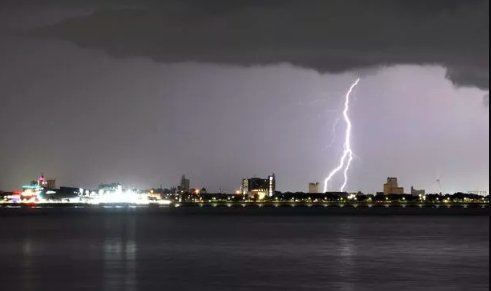Flash flooding, lightning, and hail expected as Met Office issues two alerts for Sunday and Monday
Scotland’s muggy midsummer weekend has taken a sharp turn for the worse, with back-to-back weather warnings issued for thunderstorms and heavy rainfall. What began as a yellow alert for rain has now escalated into a double whammy — with the Met Office warning of disruptive storms hitting both Sunday and Monday.
From the Borders to the Highlands, much of the mainland is now braced for flash flooding, lightning strikes, and bursts of hail, with transport disruptions expected across the board.
Sunday starts wet — and gets worse
The first alert of the weekend was already in place before the second one even dropped. A yellow warning for rain, issued Saturday, blanketed large parts of mainland Scotland and was set to run until midday on Sunday.
But by late Saturday, the Met Office added another layer of trouble.
From midday to 10pm on Sunday, a yellow thunderstorm warning is in effect — covering the Central Belt, Dumfries and Galloway, the Borders, southern parts of the Highlands, and areas around Fife and Perth and Kinross.
That’s not just a drizzle. We’re talking 30 to 40mm of rainfall in a few short hours, enough to overwhelm drains and send water spilling across roads.
And that’s just part of the story.

Lightning, hail, and delays on the rails
It’s not just rain falling from the sky. This storm system is dragging in lightning, hail, and the risk of localized flooding. The thunderstorm warning makes clear that:
-
Driving conditions could become treacherous due to sudden downpours.
-
Bus and train services may be delayed or cancelled altogether.
-
Power cuts caused by lightning strikes aren’t out of the question.
One sentence. Let it breathe.
The advice? Check before you travel, and maybe keep the umbrella — and a backup — close at hand.
A soggy Monday too? Oh yes
Don’t pack away the waterproofs just yet. Monday’s forecast offers no real reprieve. In fact, it could be worse for many.
The second yellow thunderstorm alert — this one active from 11am to 9pm on Monday — expands the risk zone to cover nearly all of mainland Scotland, with the exception of the Northern and Western Isles and parts of the northeast.
Heavy, slow-moving showers are expected throughout the day, dumping another 30 to 50mm of rain over just a few hours. That’s enough to cause more flash flooding, especially in areas already waterlogged from Sunday.
Just one sentence here.
And yes — lightning, hail, and gusty winds are back on the menu too.
From heatwave to washout in seven days
It’s hard to believe that just a week ago, Scotland was basking in borderline heatwave conditions. But that’s summer for you — sunshine one Saturday, storm chaos the next.
STV weather presenter Philip Petrie didn’t sugarcoat it.
He described the weekend as “fairly unsettled and changeable,” with low pressure dominating the atmosphere. “We’ll see pulses of rain and isolated thunderstorms across the country,” he said, adding that muggy nights would only worsen the discomfort.
In his Sunday forecast, Petrie explained how storms would push in from the east, spreading into central and western parts through the afternoon. Monday, he warned, could be even more disruptive.
What areas are at risk?
Here’s a quick look at which areas are affected by the two warnings:
| Date | Time | Areas Covered | Main Threats |
|---|---|---|---|
| Sunday | 12pm – 10pm | Central Belt, Borders, Dumfries & Galloway, Fife, Perth & Kinross, S. Highlands | Thunderstorms, lightning, flooding |
| Monday | 11am – 9pm | Most of mainland Scotland (except NW Isles and NE coast) | Thunderstorms, flash floods, hail, wind |
Transport Scotland has urged caution, particularly for drivers using rural roads or low-lying routes near rivers and streams. Short, sharp storms could make surfaces slick, visibility poor, and crossings dangerous.
No rest for the soaked
There’s a frustrating irony in all this. After weeks of dry spells and even some water usage concerns in eastern Scotland, the heavens are now opening with a vengeance.
One sentence to break things up.
And while the storms may pass quickly, the mess they leave behind won’t vanish so fast.
Local councils have been put on alert, with emergency services expecting a higher volume of calls related to surface flooding and travel incidents. Flood alerts are also being updated regularly via SEPA and local authorities.
What should you actually do?
It might feel like there’s little you can control — but there are a few practical things folks can do.
If you’re in an at-risk area:
-
Avoid driving through standing water. It’s often deeper than it looks.
-
Unplug electronics during lightning storms to prevent damage.
-
Keep an eye on live public transport updates — especially ScotRail and local bus services.
-
Check your garden drains and gutters if it’s safe to do so.
-
Maybe reschedule that weekend hike or BBQ — it’s not worth getting caught in a cell.
And yes, definitely skip the hillwalking.
Is this the new summer normal?
Weather like this doesn’t feel rare anymore. The quick flip from heatwave highs to flood warnings is starting to feel routine — and meteorologists say that’s not coincidence.
One final single-sentence paragraph.
Climate volatility is here, and Scotland’s weather is becoming less predictable, more extreme, and harder to plan around.
While we’re used to a bit of drizzle, the kind of sudden, violent thunderstorms hitting this weekend are likely to become more common. That means more warning days, more disruption, and more damage.
But for now, all most Scots can do is stay indoors, brew a tea, and hope their windows hold.


















